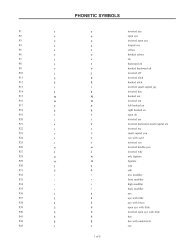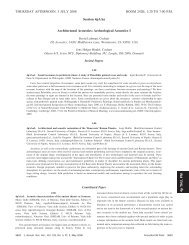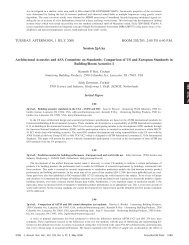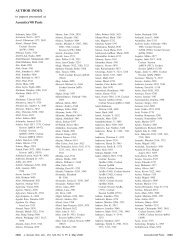Tuesday afternoon, 11 November - The Acoustical Society of America
Tuesday afternoon, 11 November - The Acoustical Society of America
Tuesday afternoon, 11 November - The Acoustical Society of America
You also want an ePaper? Increase the reach of your titles
YUMPU automatically turns print PDFs into web optimized ePapers that Google loves.
may enhance attention to pitch and thereby facilitate pitch-pattern<br />
discrimination. However, learned linguistic pitch-pattern categories may interfere<br />
with novel, nonlinguistic, pitch-patterns, thereby impairing identification<br />
<strong>of</strong> musical pitch-patterns. Our study contributes to a literature suggesting<br />
that processing <strong>of</strong> music-pitch and speech-pitch utilizes shared<br />
cognitive mechanisms e.g., Alexander et al., Interspeech 2005. Results are<br />
discussed with regard to a cognitive-processing framework that involves the<br />
influence <strong>of</strong> experientially acquired top-down pitch category information<br />
upon novel bottom-up pitch input during certain tasks. Work supported by<br />
NU Cognitive Science Graduate Fellowship to J.A. and NIH Grants<br />
DC005794 to A.B. and HD051827 DC007468 to P.W.<br />
2pSC9. Similarities in the acoustic expression <strong>of</strong> emotions in English,<br />
German, Hindi, and Arabic. Marc Pell, Silke Paulmann, Chinar Dara,<br />
Areej Alasseri School <strong>of</strong> Commun. Sci. and Disord., McGill Univ., Montreal,<br />
QC H3G 1A8, Canada, and Sonja Kotz Max Planck Inst. for Human<br />
Cognit. and Brain Sci., Leipzig, Germany<br />
Based on the hypothesis that emotion expression is in large part biologically<br />
determined “universal”, this study examined whether spoken utterances<br />
conveying seven emotions anger, disgust, fear, sadness, happiness,<br />
surprise, and neutral demonstrate similar acoustic patterns in four distinct<br />
languages English, German, Hindi, and Arabic. Emotional pseudoutterances<br />
the dirms are in the cindabal were recorded by four native speakers<br />
<strong>of</strong> each language using an elicitation paradigm. Across languages, approximately<br />
2500 utterances, which were perceptually identified as communicating<br />
the intended target emotion, were analyzed for three acoustic<br />
parameters: f0Mean, f0Range, and speaking rate. Combined variance in the<br />
three acoustic measures contributed significantly to differences among the<br />
seven emotions in each language, although f0Mean played the largest role<br />
for each language. Disgust, sadness, and neutral were always produced with<br />
a low f0Mean, whereas surprise and usually fear and anger exhibited an<br />
elevated f0Mean. Surprise displayed an extremely wide f0Range and disgust<br />
exhibited a much slower speaking rate than the other emotions in each<br />
language. Overall, the acoustic measures demonstrated many similarities<br />
among languages consistent with the notion <strong>of</strong> universal patterns <strong>of</strong> vocal<br />
emotion expression, although certain emotions were poorly predicted by the<br />
three acoustic measures and probably rely on additional acoustic parameters<br />
for perceptual recognition.<br />
2pSC10. Acoustic correlates <strong>of</strong> vocal effort. Stephen Tasko Dept. <strong>of</strong><br />
Speech Pathol. and Audiol., Western Michigan Univ., 1903 W. Michigan<br />
Ave., Kalamazoo, MI 49008-5355, stephen.tasko@wmich.edu, Madalyn<br />
Parker Kalamazoo Area Math and Sci. Ctr., Kalamazoo, MI 49008, and<br />
James Hillenbrand Western Michigan Univ., Kalamazoo, MI 49008-5355<br />
This study evaluated the influence <strong>of</strong> open quotient OQ, fundamental<br />
frequency F0, and intensity on listener ratings <strong>of</strong> vocal effort for isolated<br />
synthetic vowels. Glottal waveforms duration: 1000 ms were synthesized<br />
using a model developed by Rosenberg J. Acoust. Soc. Am. 49, 583–590<br />
1971. Signals were generated using six different OQs ranging from 0.2 to<br />
0.7 at each <strong>of</strong> eight distinct F0 values. Four F0 values were in a typically<br />
male range 100–142 Hz and four in a typically female range 178–253<br />
Hz. <strong>The</strong> glottal waveforms were passed through formant resonators with<br />
formant frequency settings characteristic <strong>of</strong> the vowel /a/. Signals were randomly<br />
presented at 80, 83, and 86 dBA to 20 listeners who used visual analog<br />
scales to rate each sample on dimensions <strong>of</strong> vocal effort, loudness, pitch,<br />
breathiness, and naturalness. Mean vocal effort ratings showed a weak negative<br />
association with OQ r0.34 and weak-moderate positive associations<br />
with F0 r0.45 and intensity r0.55. Multiple regression analysis<br />
revealed that a linear combination <strong>of</strong> the three variables accounted for 68%<br />
<strong>of</strong> the variance in vocal effort ratings. <strong>The</strong>se results suggest that the perception<br />
<strong>of</strong> vocal effort relies on multiple acoustic cues.<br />
2pSC<strong>11</strong>. Perceived age in normal and disordered voices. Dorothy<br />
Bourgeois, W.S. Brown, Jr., Rahul Shrivastav, Howard Rothman, and James<br />
D. Harnsberger Dept. <strong>of</strong> Commun. Sci. and Disord., Univ. <strong>of</strong> Florida,<br />
Gainesville, FL 326<strong>11</strong><br />
An experiment was conducted to identify the contribution <strong>of</strong> voice quality<br />
to perceived age. Voice quality effects were assessed in age estimation<br />
experiments using 1 natural pathological stimuli that incorporated voice<br />
qualities <strong>of</strong> interest and 2 young normal voices in which two voice cues,<br />
hoarseness and tremor, were modified through resynthesis. <strong>The</strong> disordered<br />
samples included single sentences from 227 talkers included in the Kay Elemetrics<br />
database <strong>of</strong> disordered samples. <strong>The</strong> resynthesized samples were<br />
sentences from ten young males in which 1 the f0 contour was multiplied<br />
by a random number within a fixed range hoarseness or 2 a5–9-Hz wave<br />
with an amplitude <strong>of</strong> 7.5% <strong>of</strong> the original f0 value was incorporated<br />
tremor. Sixty navive listeners estimated all speakers ages in years. <strong>The</strong> results<br />
demonstrated that disordered voices were overestimated in age by <strong>11</strong><br />
years, with the greatest mismatch in chronologic and perceived age reaching<br />
47 years older. <strong>The</strong> addition <strong>of</strong> synthetic tremor and hoarseness shifted perceived<br />
age older by 8 and 5 years, respectively. In summary, voice quality<br />
appears to play a significant role in the perception <strong>of</strong> perceived age, comparable<br />
to or exceeding other cues that have been identified to date.<br />
2pSC12. Perception <strong>of</strong> falling and rising pitch contour contrast: Effects<br />
<strong>of</strong> first language background. Ratree Wayland, Mingzhen Bao, and Edith<br />
Kaan Program in Linguist., Univ. <strong>of</strong> Florida, Gainesville, FL 32607, ratree<br />
@ufl.edu<br />
<strong>The</strong> main objective <strong>of</strong> this study is to examine the ability to discriminate<br />
falling and rising pitch contour contrasts among native speakers <strong>of</strong> a tonal<br />
language Chinese and native speakers <strong>of</strong> a nontonal language English.<br />
Linearly falling and rising pitch contours on ba: syllables are presented to<br />
participants in 1 the “same different categorial” discrimination task and 2<br />
an “oddball” detection task. Preliminary results obtained from 10 Chinese<br />
and 12 English speakers suggested that a native Chinese speakers found<br />
the falling contour to be easier to discriminate than the rising contour, while<br />
the ability to discriminate between the two pitch contours was comparable<br />
among the English speakers, b reaction time for the falling contour false<br />
alarms was longer than for the rising contour among the English speakers,<br />
c no difference in either “detection” rate or “reaction” time between the<br />
two contours was found among both groups <strong>of</strong> speakers. More data will be<br />
collected from both groups <strong>of</strong> speakers and from speakers <strong>of</strong> another tonal<br />
language. Language general as well as language specific factors will be considered<br />
to account for the patterns <strong>of</strong> results obtained.<br />
2pSC13. <strong>The</strong> production and perception <strong>of</strong> prenuclear second<br />
occurrence focus. Melissa Wake, Jason Bishop, and Cathryn Panganiban<br />
Dept. <strong>of</strong> Linguist., Univ. <strong>of</strong> California, Los Angeles, 3125 Campbell Hall,<br />
Los Angeles, CA 90095, mwake@ucla.edu<br />
Semantic focus in English is typically marked by intonational prominence,<br />
most canonically by a pitch accent. One case that has been presented<br />
as an exception to this generalization, however, is that <strong>of</strong> second occurrence<br />
SO focus. An SO focus is a repeated but focused item, usually associated<br />
with a focus sensitive operator such as “only” or “even.” Previous studies<br />
have suggested that SO foci lack pitch accents for phonological rather than<br />
information structural reasons, in most cases examining such foci in the<br />
postnuclear domain. We present acoustic and phonological data that demonstrate<br />
that SO foci also lack considerably in intonational prominence<br />
particularly in terms <strong>of</strong> F0 when prenuclear, although they show increased<br />
duration. Additionally, the perceptibility <strong>of</strong> prenuclear SO focus is tested.<br />
Perceptually weak prosodic marking would suggest an important role for<br />
pragmatics in a focal interpretation, as has been suggested previously for SO<br />
focus.<br />
2pSC14. Perceived prosody: Phonetic bases <strong>of</strong> prominence and<br />
boundaries. Jennifer Cole Dept. <strong>of</strong> Linguist., Univ. <strong>of</strong> Illinois, 707 South<br />
Mathews, Urbana, IL 61801, jscole@uiuc.edu, Louis Goldstein, Argyro<br />
Katsika Haskins Labs., New Haven, CT 065<strong>11</strong>, Yoonsook Mo Dept. <strong>of</strong><br />
Linguist., Univ. <strong>of</strong> Illinois, Urbana, IL 61801, Emily Nava, and Mark Tiede<br />
Haskins Labs., New Haven, CT 065<strong>11</strong><br />
In comprehending speech, listeners are sensitive to the prosodic features<br />
that signal the phrasing and the discourse salience <strong>of</strong> words prominence.<br />
Findings from two experiments on prosody perception show that acoustic<br />
and articulatory kinematic properties <strong>of</strong> speech correlate with native listeners’<br />
perception <strong>of</strong> phrasing and prominence. Subjects in this study were <strong>11</strong>4<br />
university-age adults 74 UIUC 40 Haskins, monolingual speakers <strong>of</strong><br />
<strong>America</strong>n English who were untrained in prosody transcription. Subjects listened<br />
to short recorded excerpts about 20 s from two corpora <strong>of</strong> spontaneous<br />
and read speech Buckeye Corpus and Wisconsin Microbeam<br />
Database and marked prominent words and the location <strong>of</strong> phrase bound-<br />
2496 J. Acoust. Soc. Am., Vol. 124, No. 4, Pt. 2, October 2008 156th Meeting: <strong>Acoustical</strong> <strong>Society</strong> <strong>of</strong> <strong>America</strong><br />
2496







